Spring grape care: opening after winter, garter, pruning, processing, fertilizing
If you want your grapes to produce a bountiful harvest each year, they need to be looked after carefully. In this case, special attention should be paid to the vine in the spring.
Below you will find useful information on how to properly care for grapes in the spring for a bountiful harvest.
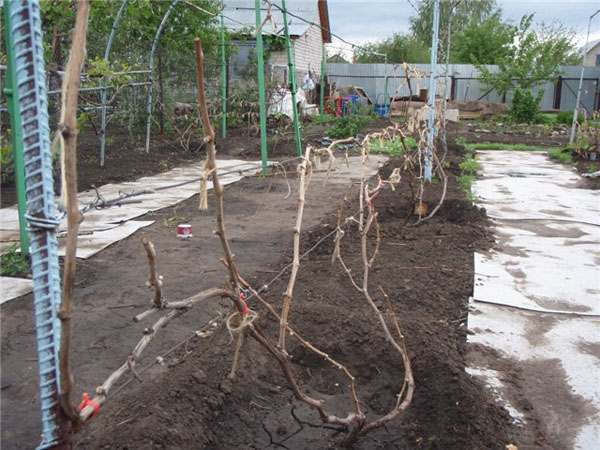
Content
What is included in spring grape care
So, what activities are included in the list of basic grape care in spring:
- removal of the winter shelter;
- sanitary and corrective formative pruning, as well as green operations, which are more often called summer pruning (pinching, embossing, pinching, rationing of bunches);
- treatment of vines from diseases and pests;
- garter;
- feeding;
- watering, loosening and weeding.
Video: caring for grapes in spring
By the way! Even in spring you can plant a grape seedling or germinate and plant a vegetative cutting in the groundand also execute vaccination.
Taking shelter after winter
The very first action that a vineyard should carry out in his vineyard is to open the vine on time and correctly.
- With the onset of warming (snow melting) and the establishment of minimum positive temperatures (+5 during the day), you first need only slightly open the shelter (open the ends)so that air gets inside and the bush is ventilated, and the vine does not melt (does not straighten out under the shelter, especially if it is a film or similar shelter).
Advice! If the weather is immediately stable and warm, then, as an option, you can remove the regular shelter and make a lighter one (just cover it with a spanbond) to protect grapes from return frost, and after them - open completely.
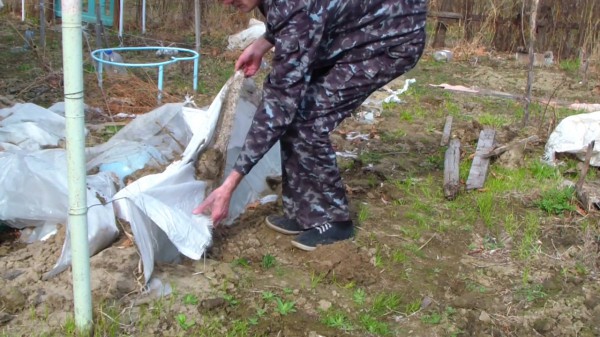
- Wherein you need to remove the shelter carefully, otherwise you can damage (break off) the swelling buds on the vine.
- And when the returnable night frosts pass and stable warm weather will be established (above +10 during the day and +5 at night), then remove the cover completely.
In the next video, the grower shares his personal opinion regarding the timing of the removal of the shelter and the factors influencing it.
Video: when to open grapes in spring
What to do right after opening
Take a close look at the vine on the subject underpinning, which could arise due to the fact that moisture got inside the shelter in winter or the vine was lying on wet ground.
How do you know if the vine has sprouted?
The vines will turn black, stains and mildew may form.

If you find such moldy shoots that are undergone, then it is advisable to quickly remove the shelter and, choosing a dry, fine day, spend early spring processing bushes copper sulfate or Bordeaux liquid (2-3% solution before bud break and / or 1% after bud break). This way you can disinfect the vine from diseases and mold.
Advice! After opening, you do not need to immediately tie the vines to the first wire of the trellis (perform a "dry tie"). Let them first straighten out on their own, and then do their garter.
Why it is believed that there is no need to rush to open bushes after winter
The fact is that if there are recurrent frosts (-2 ..- 3 degrees), then the opened buds can simply freeze out and then you will most likely simply be left without a fruiting vine. Of course, the bush itself will recover a little later - spare buds will soon wake up from the old wood (closer to the roots), but ... in this case, you can count on the harvest only next year.
However! There is an opinion that it is better not to wait until the return frosts have passed, but to remove the shelter immediately after the snow melts and a stable positive night temperature is established.
Try ...
Spring pruning of grapes
Remember! Basic pruning of table grapes always do exactly in the fall.
In the spring only sanitary pruning, in other words, frozen and damaged shoots are pruned to healthy wood.
However, many growers in case of death (damping out, freezing) of the vine and eyes, leave spare vines and eyes. Accordingly, in the spring you need to carry out corrective (formative) pruning:
- If you specifically (so to speak, "in reserve") left longer vines, for example, with 10-15 eyes, then in the spring they need to be pruned to the optimal 6-10 eyes (depending on the variety).
- The same goes for whole spare shoots left for fruiting.They also need to be completely eliminated (removed), keeping only those that are located closer to the base of the bush.
Those. need to spend normalization of fruitful shoots and eyes on them depending on your method of formation.
At the same time, it is worth knowing that the late spring pruning of the vine will cause it "cry", Which will release sweet juice (molasses). Therefore, it is advisable to prune as early as possible, even before the start of active sap flow, preferably in early spring, immediately after the first opening and processing (or before processing).
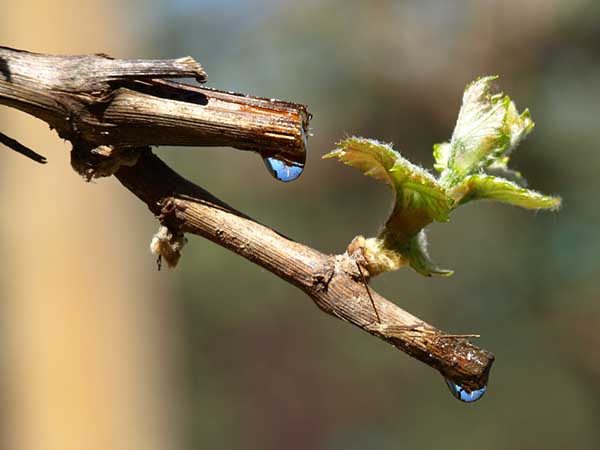
By the way! There is also a separate article on our website about spring pruning of grapesfor other useful tips and tricks.
Another thing is non-sheltering winter-hardy technical (wine) varieties. They are pruned in the spring.
You can find out about the nuances of spring pruning of these grape varieties by watching the following video:
Other green cropping operations
Towards the end of spring and early summer, when the buds actively begin to bloom and green shoots grow, several spring green operations need to be carried out:
- After tying the grapes on the trellis, it is very important remove all open eyes that are located below the lower wire, with the exception of those that are on replacement knots.
Moreover, it is necessary to remove not only the extra lowest eyes (buds) on the fruit-bearing vines, but also to break off the unnecessary (they are also called "tops") shoots formed on the lower part of the trunk (perennial wood).
- Delete all root growththat forms next to perennial wood.
- Carry out a wreck of twin shoots (tees), leaving only the strongest shoots. The fact is that from one eye (since there are several buds in it) several shoots can form at once, and only one needs to be left.
What is the purpose of green operations?
Avoid thickening of the bushes, so that there is good ventilation inside (the bushes are blown through) and lighting. Then the grapes will develop well and bear fruit (the harvest will be more abundant, the berries are larger and ripen faster). Also, in this way, you will save the bush from unnecessary shoots, on which it would spend its strength and food.
Summer pruning
Summer pruning of grapes also provides for the following green operations (therefore they also say "green pruning of grapes"):
- Pinching the tops of the shoots (before flowering or after, in no case during).
More about what is pinching and how to do it, you can read in this paragraph.
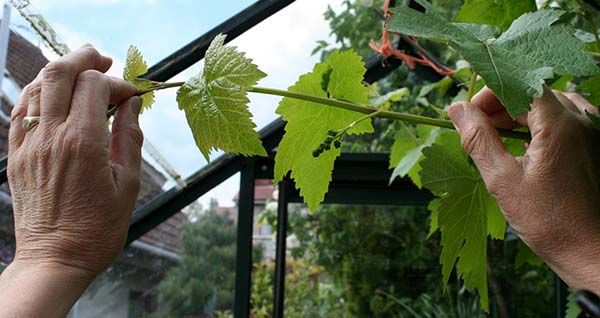
- Chasing shoots.
On the summer minting of grapes everything is told in this article (also about the differences from pinching).
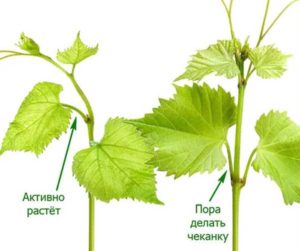
- Grasshopping (removal of excess shoots and leaves).
The site also contains material about when and how to pinch grapes.
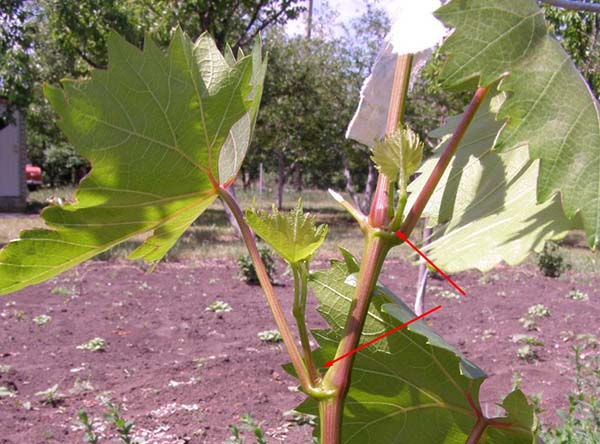
- Removal of whiskers and other green operations: removal of part of the leaves in autumn after the heat, as well as thinning of the brushes (more on this later).
Rationing of bunches
After the formation of ovaries (much larger than a pea) on the bunches, they need to be rationed (i.e. already in the summer).
Important! You need to cut off the extra bunches after the berries have begun to take on the characteristic shape corresponding to the variety. Only in this case will you be able to see and remove the extra brush, which has developed defective berries, and leave the bunch on which pollination was successful.
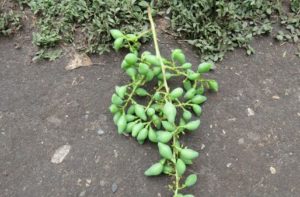
The optimal load on the bushes, depending on the variety, is as follows:
- For table varieties - 1 bunch, that is, leave one more developed brush for 1 shoot, and remove the second (as a rule, remove the upper bunch). As a result, no more than 20-25 bunches should be left for 1 bush.
- For universal and technical (wine) varieties — 2-3 bunches, i.e. you need to leave 2-3 more developed brushes and 50-60 clusters per 1 bush.
Why do you need to normalize bushes?
The fact is that if you overload the bushes, the vines will form thin and weak, which means that the next year's harvest will be less. Ripening will naturally be faster.
Garter grapes
After a positive temperature is established and / or the threat of recurrent spring frosts has passed, the shelter will need to be completely removed and the vine tied to the trellis, doing this in 2 stages:
- The first garter of last year's shoots (left for fruiting - they are called fruit links) are carried out horizontally to the lower wire of the trellis (approximately at a height of 30-40 cm from the ground). This garter is also called "dry"(Since the shoots are lignified).
Why horizontal? The fact is that if in the spring you carry out sanitary pruning or simply shorten the vines to the optimal number of eyes, the bush will cry. So these drops of "molasses" can get on the eyes, because of which they burn out in the sun = die.
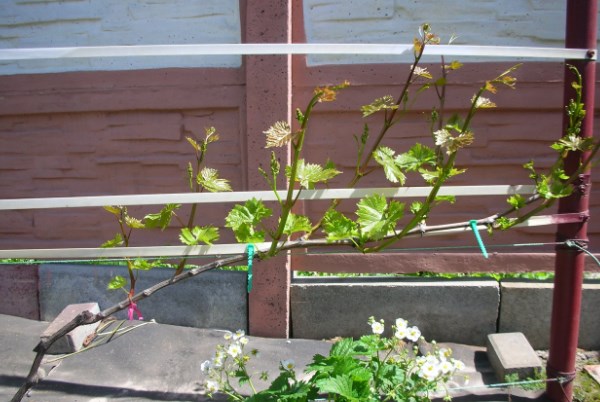
- A little later (after regrowth) they carry out second garter of green shoots vertically to the wires of the trellis, doing it as carefully as possible, because shoots are very brittle.
- After a while, the green shoots are again tied to the higher wires of the trellis.
Advice! All the information you need to know how to tie up grapes correctly, what methods exist, you'll find in this article.
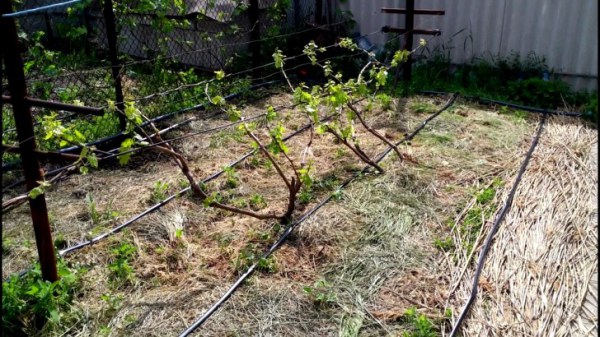
Spring processing of grapes from diseases and pests
Like high humidity (frequent rains) and relatively low temperatures (mildew grapes), and dry and hot weather without rain (oidium grapes) - all this is an ideal environment for the development of diseases and pest attacks.
Therefore, in order to protect the vine and save the harvest, you will need to approach this issue very seriously and implement a number of preventive spraying grapes against diseases and pests.
Note! The site has a detailed article about when and how to properly spray grapes in spring and summer, in which you will find answers to all questions regarding the timing and scheme of processing vines from diseases and pests.
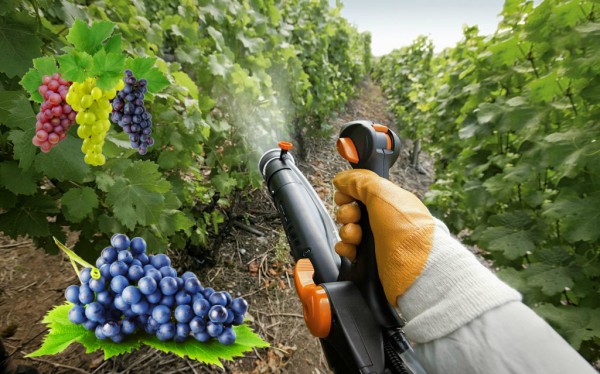
Watering grapes in spring
As a rule, in the spring the grapes do not need additional watering (the moisture accumulated over the winter is enough in excess), except in the period before and after flowering (i.e., in summer).
However, if you did not do the autumn water charging and the winter was snowless (there was very little rainfall), then in early spring you should spend spring water charginghaving managed before bud break (you can and immediately after), to saturate the bushes with the necessary moisture to start active sap flow in the shoots.
- Water consumption for 1 adult bush - from 50 to 100 liters.
Note! If you did the autumn water-charging irrigation, then you do not need to do the spring irrigation, especially if the winter was snowy and the soil is saturated with moisture. Otherwise (too much moisture), you will only harm your bushes.
Further, it is very important to water 10-14 days before flowering and 1-2 weeks after flowering and ovary formation, but in no case during the flowering period itself, because excess moisture during flowering causes “peas "and thinness of bunches.
All the information about when and how to water the grapes (including the most effective ways) you can find in this detailed article.
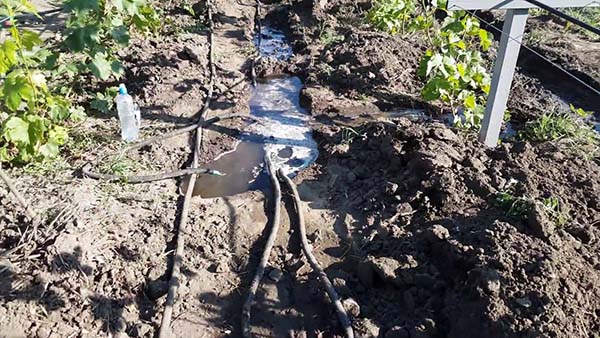
Loosening and weeding
After each watering (rain), if your bush is not mulched, then a crust does not form and to improve oxygen access at the roots, you need to carry out shallow loosening of the root zone of the vines. And also don't forget weed out.
Spring feeding of grapes
For a good start of growth and further successful development of a grape bush, it must be fertilized.
The first feeding of grapes in the spring is most advisable only after the snow melts, stable warm weather sets in (above zero at night) and the plant begins to grow shoots (the first leaves appear).
By the way! It is convenient to combine top dressing with watering.
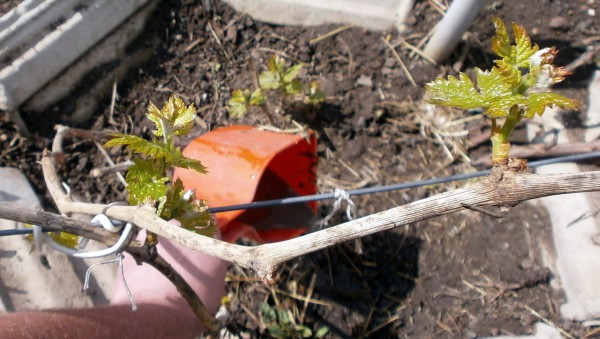
The first time after opening the grapes need to be fed nitrogen fertilizers, for example, solution urea or ammonium nitrate.

You can also use the infusion of mullein or chicken droppings.
Before flowering, the grapes also need to be fed with potassium fertilizer, for example, a solution of potassium sulfate.
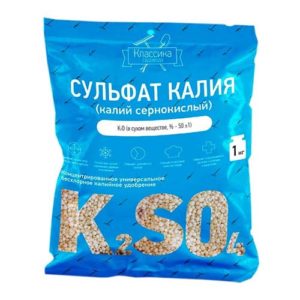
The best and only organic analogue of potash fertilizer is wood ash.
Or you can do it easier and apply full complex fertilizers such as Nitroammofoski (nitrogen, phosphorus, potassium - 16% each),
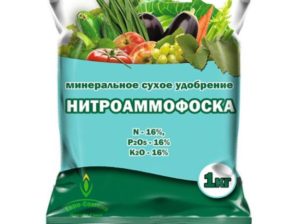
either Fertika Lux (also contains useful trace elements), or any other fertilizer marked "Spring-Summer".

By the way! The site already has a detailed article about how and what to feed grapes in spring and summer.
Video: how to properly fertilize and feed grapes
What can be done in the spring in the vineyard
In addition to the basic activities for the care of grapes, in the spring you can also carry out several operations for planting, transplanting, propagating by cuttings and updating through grafting,
Graft
If you decide to re-graft a new variety (for example, more winter-hardy) on old wood, then the grafting procedure will help you with this.
About all methods of grafting grapes You can find out from this material.
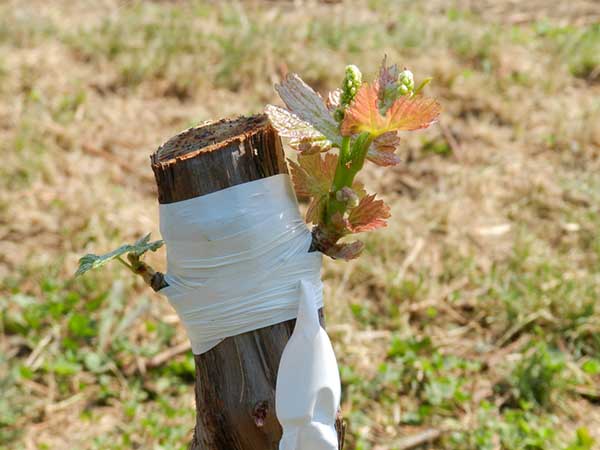
Planting and transplanting
In general, spring is also a great time to lay a vineyard, in other words, plant grape seedlings.
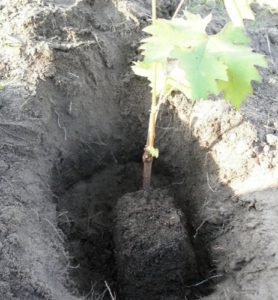
Important! The planting of young grape seedlings is started after the soil warms up above +12 .. + 15 degrees.
Also in the spring you can transplant grapes to a new (different) place.
By the way! How to transplant grapes will be discussed in one of the future articles on the site. In the meantime, you can watch the next very sensible video.
Video: how to properly transplant an adult grape bush
Germination and planting of vegetative cuttings in the ground
If you want to propagate grapes by cuttings, then spring is the right time. You just need to purchase the desired planting material (cuttings) and put them for germination.
Advice! The site already has detailed material about how to germinate and plant grapes cuttings in spring.
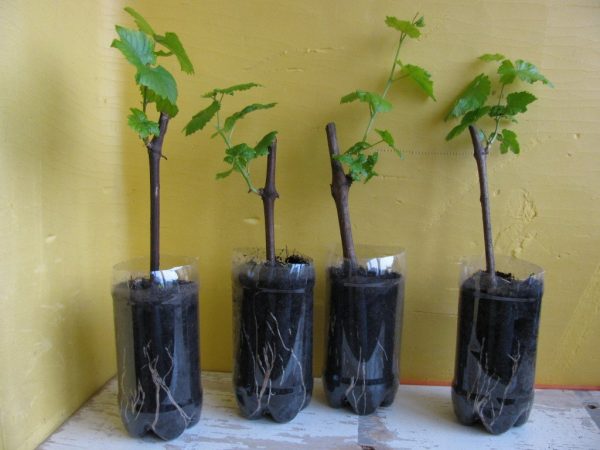
So you know whether the grapes will bear fruit abundantly this year - directly depends on how well you have carried out the spring care of the grapes. Good luck!
Video: how to care for grapes in spring

